Many radioactive isotopes emit X-rays together with α- or β-rays. In nature only the isotopes with very large half-lives and traces of their decay products in their neighbourhood can still be found. These are mainly [half lives; y=year, d=day, h=hour, m=minute, s=second]:
3H [12.3 y], 14C [5730 y], 36Cl [3.0E5 y], 40K [1.3E9 y], 210Pb [22.3 y], 220Rn [55.6 s], 232Th [1.4E10 y], 234U [2.5E5 y], 235U [7.0E8 y], 238U [4.5E9 y] and Pu.
More radioisotopes have been produced artificially. Some of them are used as technical X-ray sources for industrial, medical or military purposes. The table below gives some of these isotopes and their use:
| Isotopes (+ daughters) [half lives+] | Occurrence* |
| 222Rn [3.8 d], 235U [7.0E8 y], 238U [4.5E9 y], Pu | Nuclear fuel cycle (mining, enrichment, fuel fabrication, nuclear waste) |
| 3H [12.3 y], Kr, Xe, 88Rb [17.8 m], Sr, I, Cs, 51Cr [27.7 d], N, Co, Mg, 41Ar [109.3 m] | Reactor operation (plus those above) |
| 99Tc [2.1E5 y], 123I [13.3 h] | Medical diagnostic imaging and therapy |
| 60Co [5.3 y], 137Cs [30.1 y], 192Ir [73.8 d], 131I [8.0 d], 125I [59.4 d], 226Ra [1600 y], 32P [14.3 d], 103Pd [17.0 d] | Oncologic radiology for therapy |
| 3H [12.3 y], 125I [59.4 d], 32P [14.3 d], 35S [87.3 d], 14C [5730 y] | Biomedical research |
| 3H [12.3 y], 63Ni [100.1 y], 137Cs [30.1 y], 147Pm [2.6 y], 226Ra [1600 y], 232Th [1.4E10 y], (depleted) U, 241Am [432.2 y] | Military equipment |
| 3H [12.3 y], 14C [5730 y], 36Cl [3.0E5 y], 210Pb [22.3 y] | Industrial used natural sources for e.g.: studying sewage and ground water, age measurement, measuring sources of chloride, dating layers of soil and sand |
| 46Sc [83.8 d], 110mAg [250 d], 60Co [5.3 y], 140La [1.7 d], 198Au [2.7 d], 51Cr [27.7 d], 192Ir [73.8 d], 54Mn [312 d], 65Zn [244 d], 57Co [272 d], 60Co [5.3 y], Fe, 82Br [35.3 h], 85Kr [10.8 y], 90Sr [28.8 y], 144Ce [285 d], 147Pm [2.6 y], 99mTc [6.0 h], 137Cs [30.1 y], 169Yb [ 32.0 d], 170Tm [128 d], 192Ir [73.8 d], 239Pu [24110 y], 241Am [432 y], 252Cf [2.6 y] | Industrial used artificial sources for e.g.: blast furnace, studying coastal erosion, predicting behaviour of heavy metal components in mining, soil analysis, food irradiation, industrial radiography, gamma sterilization, hydrological tracing, reservoir engineering, radiation gauges, automatic weighing equipment, tracing liquid waste movements, radiography, borehole logging, smoke detectors |
Information sources:
+Table of Radioactive Isotopes, LBNL Isotopes Project - LUNDS Universitet
* "Disaster Preparedness for Radiology Professionals", American College of Radiology (ACR) ©2006
Some of these radionuclides are packaged in shielded housings with sample volumes in the mm3 to cm3 range and used as illumination sources for imaging or therapeutic purposes. Specific activities in the range of some TBq g-1 are reached, resulting in total activities for such samples up to the 1000 TBq range.
To form technical X-ray sources, radionuclides are packaged in shielded housings with an opening to release the X-rays when needed. There are housings with a shutter or a door in front of the shielded source (fig. 1 top), housings where radiation is released by turning an insert containing the shielded radioactive sample in an outer shielding with a hole (fig. 1 middle) and housings where a Bowden cable positions the source in the middle of a S-shaped feedthrough when not in use (fig. 1 bottom). In the figures the radionuclides are marked as red ball.
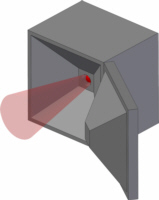 |
 |
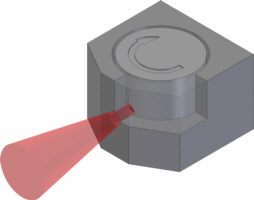 |
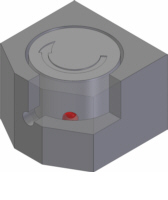 |
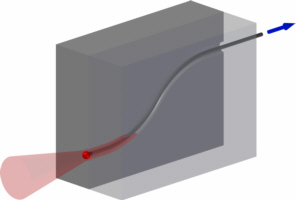 |
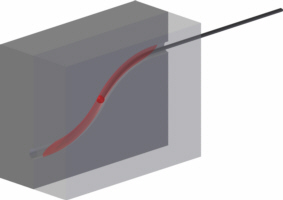 |
Fig. 1: Pb-shieldings for radioactive X-ray sources (partly transparent for illustration)


